Clients with a disability
The 2012 Survey of Disability, Ageing and Carers (SDAC) estimates that almost 1 in 5 Australians have a disability. This estimate includes all those with any disability including mild and severe disabilities [1]. The SHSC identifies people with core activity limitations and their level of need for assistance in different life areas including those that may impact on housing and employment, and differentiates them from people without activity limitations. The analysis of the availability and appropriateness of homelessness services for this group of clients allows for comparable information about people with disability across a range of government services.
The reporting of disability in the SHSC
The SHSC disability questions are asked of all clients and are based on core activity limitations and whether the client has any need for assistance with these activities. In this report, people who identified that they had a limitation in core activities (self-care, mobility and/or communication) and who also reported that they always or sometimes needed assistance with the core activities are described as having a disability. Details about measuring disability in the SHSC and the definition of a client with a disability are provided in the Technical information section.
In 2014–15 23,272 clients (or 11% of the SHS population) reported a limitation with a core activity. The distribution of these clients, by the extent of their need for assistance, is presented in Figure DIS.1. The categories of self-care, mobility and communication are not mutually exclusive as a client can have a need for assistance for more than one core activity.
Of the 23,272 clients reporting a limitation with self-care, mobility or communication:
- 38% always or sometimes needed assistance
- 40% have difficulty but don’t need assistance
- 22% did not have difficultly but used aids/equipment.
Figure DIS.1: Clients reporting core activity limitations, by extent of need for assistance with core activities, 2014–15
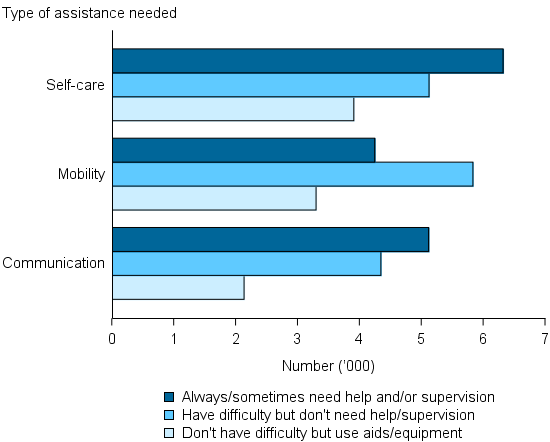
Source: Specialist homelessness services 2014–15, National supplementary table DIS.2 (702KB XLS).
Of the 3 categories of core activities:
- About 15,000 clients reported self-care limitations, of which 27% always/sometimes needed help and/or supervision
- About 13,000 reported mobility limitations, and 18% always/sometimes needed help and/or supervision
- Nearly 12,000 clients reported communication limitations, of which 22% always/sometimes needed help and/or supervision.
Clients with a disability who require assistance
This is the second year for which information on clients based on core activity limitations together with their level of need for assistance has been collected. In 2014–15, of the 23,272 clients who had a core activity limitation, 8,789 clients (or 4% of all SHS clients) answered that they ‘always/sometimes need help and/or supervision’ with self-care, mobility or communication (Table DIS.1). It is these clients who are described in this section.
| 2013–14 | 2014–15 | |
|---|---|---|
| Number of clients (proportion of all clients) | *6,979 (4%) | 8,789 (4%) |
| Rate (per 10,000 population) | 3.0 | 3.7 |
| Housing situation at the beginning of first support period (all clients) | ||
| Homeless: At risk of homelessness | 42%: 58% | 43%: 57% |
| Living arrangement | ||
| Lone person | 37% | 34% |
| Sole parent | 26% | 27% |
| Couple with child/ren | 10% | 10% |
| Couple without children | 7% | 6% |
| Other family group | 20% | 23% |
| Main reason for seeking assistance (Top 3) | ||
| Housing crisis | 18% | 21% |
| Inadequate or inappropriate dwelling conditions | 15% | 12% |
| Domestic and family violence | 14% | 15% |
| Proportion receiving accommodation (median (nights)) | 42% (58) | 40% (55) |
| Average (median) length of support (days) | 121 (68) | 108 (59) |
| Number of support periods (average per client) | 16,382 (2.3) | 19,541 (2.2) |
| Proportion of a client group with a case management plan | 50% | 68% |
| Achievement of all case management goals | 18% | 19% |
Notes
-
Rates are crude rates based on the Australian estimated resident population (ERP) at 30 June of the reference year.
-
* Indicates where previously published data have been revised to ensure consistent reporting over time.
Source: Specialist homelessness services annual reports 2013–14 and 2014–15.
In 2014–15 changes occurred in the way agencies are required to report ‘main reason’ and ‘reasons for seeking assistance’. Comparisons over time should be made with caution as the reporting of housing crisis, financial difficulties and housing affordability stress may be inconsistent between agencies. See Technical information for further details.
Support received by clients with a disability was longer than the general SHS population, suggesting that these clients are presenting with potentially more complex needs. In 2014–15 clients who always/sometimes need help and/or supervision with self-care, mobility or communication:
- Were supported on average for 108 days (median 59 days), significantly longer than the average support length of all clients (76 days (median 33 days)).
- Were more likely to receive accommodation (40%) than the general SHS population (33%), and for those who did, the length of supported accommodation was much longer (median 55 nights compared with 34 nights for the general SHS population).
Client demographics
Of the clients reporting that they always/sometimes need help and/or supervision with self-care, mobility or communication in 2014–15:
- One in 4 clients (25%) were young children aged between 0 and 9 (Figure DIS.2). Also, there was a higher proportion of people aged over 55 (18%) compared with the broader SHS population (7%).
- About 2 in 5 clients (43%, or nearly 3,600) were homeless at the beginning of their first support period, similar to the proportion of the broader SHS population (Table DIS.6).
- Twenty-two per cent of clients were Indigenous (compared with 23% of all clients).
- The majority of clients accessed services in Major cities (68%) followed by Inner regional areas (19%).
- A larger proportion were living alone (34%) compared with all SHS clients (29%) and living in other family groups (23%).
Figure DIS.2: Clients with a disability, by age and sex, 2014–15
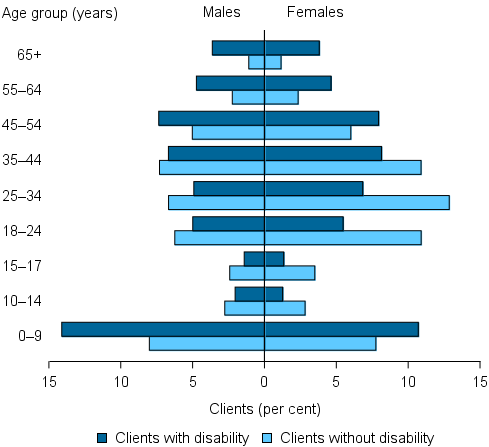
Source: Specialist homelessness services 2014–15, National supplementary table DIS.3 (702KB XLS).
States and territories
- Almost half of these clients accessed services in Victoria (43%, or 3,767 clients). This was followed by New South Wales (19%) and Queensland (15%) (Figure DIS.3).
- Most states and territories had similar proportions of clients with disability—between 3% and 6%.
Figure DIS.3: Clients with a disability, by state and territory, 2014–15
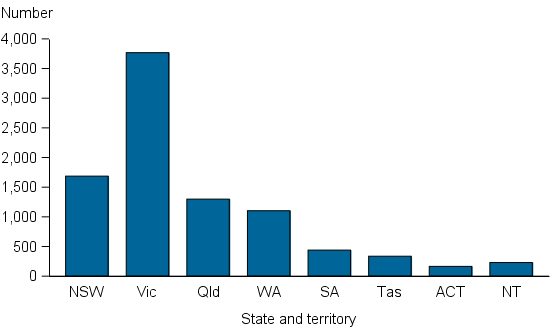
Source: Specialist homelessness services 2014–15, National supplementary table DIS.4 (702KB XLS).
Main source of income
Of clients (aged 15 and over) who required assistance for their disability (nearly 6,000), 90% reported that their main source of income was a government payment, in particular:
- Disability Support Pension (49%) (compared with 17% of all clients)
- New Start Allowance (16%) (compared with 27% of all clients)
- Age Pension (8%) (compared with 2% of all clients)
- Department of Veteran Affairs Disability Pension (3%) (compared with 1% of all SHS clients).
A larger proportion of male clients (52%) reported that their main source of income was from the Disability Support Pension, compared with females (46%). Clients who require assistance for a disability were less likely to report their main source of income as the parenting payment (6% compared with 19% of all SHS clients).
Employment status / educational status
- Of clients aged 15 and over who reported they needed help/and or supervision, the majority were not in the workforce (64%). A further 33% were unemployed.
- Only 3% of these clients were employed. By comparison, 11% of the SHS client population were employed.
- Of those aged 5–14, 23% were not enrolled in education compared with 16% of the broader SHS population. The proportion aged 15–24 who were not enrolled was similar to the general SHS client group (68% and 65%, respectively).
Source of referral
- Similar to other SHS clients, most of these clients seek support without a formal referral (32%). The most common formal referral was made by another (government/non-government) agency (15%), followed closely by a specialist homelessness agency/outreach worker (14%) and 8% were referred by family and/or friends.
- Clients who needed help/and or supervision were less likely to be referred to homelessness services by police (3%) than other homelessness clients (9%).
Reasons for seeking assistance
- The most common main reason this group of clients reported for seeking assistance was housing crisis (21%), the same proportion as the broader SHS population.
- Seven per cent reported the main reason they had sought assistance was for health related reasons.
Services needed and provided
- For clients who needed help/and or supervision the most common assistance identified as needed was for material aid/brokerage (48%), followed by ‘assistance to sustain tenancy or prevent tenancy failure or eviction’ (43%), short-term or emergency accommodation (41%) and long-term housing (44%) (Figure DIS.4).
- Most of these identified needs were provided: 89% of the need for material aid/brokerage; 84% of the need for ‘assistance to sustain tenancy or prevent tenancy failure or eviction’; and 67% of the need for short-term or emergency accommodation.
- One in 5 (21%) clients was identified as in need of health/medical services and 17% were identified as in need of mental health services. Over half of these identified needs were provided–62% for health/medical services and 53% of mental health-related services.
- Just 4% of these clients were identified as in need of physical disability services and 4% in need of intellectual disability services. About one-half of the identified need for disability services were met (45%).
- Clients who needed help/and or supervision, were more likely to need family relationship assistance (22%), assistance with challenging social/ behavioural problems (21%) and assistance for trauma (13%) than the broader SHS population (17%, 13%, 9%, respectively).
Figure DIS.4: Clients with a disability, by most needed services and service provision status, 2014–15
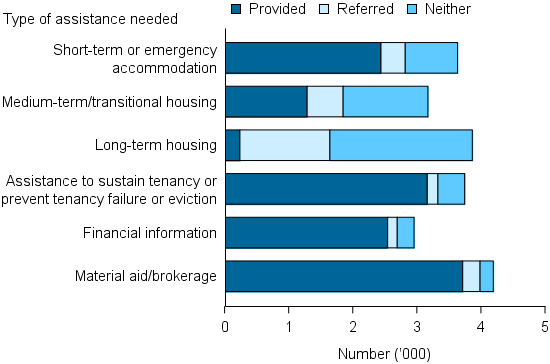
Note: Excludes ‘Other basic assistance’, ‘Advice/information’, and ‘Advocacy/liaison on behalf of client’.
Source: Specialist homelessness services 2014–15, National supplementary table DIS.5 (702KB XLS).
Previous experience of homelessness
- Forty-one per cent of clients who reported they needed help/and or supervision indicated they had experienced an episode of homelessness in the month before they commenced support. This is similar to the broader SHS population (39%).
Housing situation at the start of support
- Just over two-fifths (43%) of all clients with a disability were homeless when they started support (Figure DIS.5).
- Almost one third (31%) of clients with a disability were living in private housing at the start of their support, followed by short-term accommodation (19%).
Figure DIS.5: Clients with a disability, by housing situation at beginning of support, 2014–15
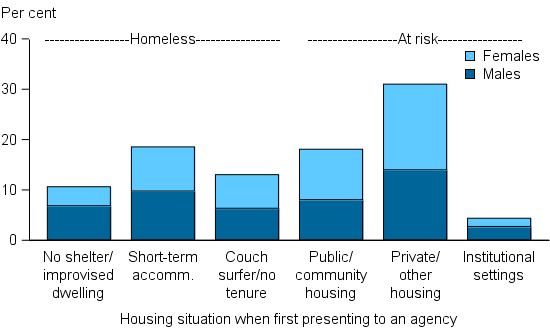
Note: Per cent calculations based on Total clients, excluding ‘Not stated’.
Source: Specialist homelessness services 2014–15, National supplementary table DIS.6 (702KB XLS).
Housing and other outcomes
Of those clients with a disability and who had closed support (about 6,200 clients):
- 41% were homeless at the start of support and this decreased to 32% by the end of support (Table DIS.7).
- 35% (or about 1,900 clients) ended support in private housing and 29% (or 1,600 clients) were housed in public or community housing.
- Data for this group indicate that clients’ labour force status and educational enrolment status is not changed after receiving support from SHS.
- For instance, the proportions of these clients unemployed or not in the labour force remain unchanged at the end of support (31% unemployed, 66% not in the labour force).
- Of those clients who needed help/and or supervision and were identified as needing assistance to obtain government allowance, there was a decrease in the proportion with no income (9% to 5%) and a reduction in those awaiting government benefit (6% to 2%).
Reference
- ABS 2013. Disability, ageing and carers, Australia. Summary of findings 2012. ABS cat no. 4430.0. Canberra: ABS.


